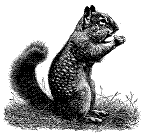Vertebrate Pest Conference Proceedings collection
Date of this Version
March 1986
Document Type
Article
Abstract
Pigeons held under a fall and spring photoperiod-temperature regime consumed a maximum of 16.9 to 21.4 kernels of whole corn per hour with an average ranging from 7.6 to 12.4 kernels per hour. Peak consumption occurred during the first and/or next to last hour of the day with a secondary, but smaller, peak around noon. Corn consumption ranged from 91 to 112 kernels/bird/day and approximated daily consumption equal to 10% of an average bird's mass.
The acute oral LD50 of strychnine alkaloid to pigeons was estimated to be 7.73 mg/kg (95% Confidence Interval of 6.75 to 8.85). The LD90 was 10.99 mg/kg (8.79 to 13.7) and the LD10 was 5.37 mg/kg (4.35 to 6.63). Time to death ranged from 5 to 39 minutes. Treatment of groups of 10 pigeons at 6-hour intervals beginning at 0600h with 7.73 mg/kg strychnine suggested that pigeons were more sensitive to intoxication at 1200h and 1800h than they were at 0600h.
Laboratory tests of 0.2, 0.4 and 0.6% strychnine-treated whole corn bait with pigeons during the first hour of the day and at noon indicated that mortality from the 0.2% bait was insufficient for adequate control (17 to 33%). The 0.4% and 0.6% baits, however, produced acceptable mortality (48 to 71%). Pigeons killed by the 0.4% and 0.6% baits consumed from 11 to 21 kernels of corn depending upon the time of ingestion. Strychnine residues in the crop and gizzard contents of pigeons consuming 0.4% and 0.6% baits ranged from 455 ppm to 1500 ppm. Residues in birds fed the 0.4% baits were 37% that of those fed the 0.6% bait during the early morning, and 49% that of birds exposed at noon. Gizzard residues ranged from 16 ppm to 38 ppm and intestinal tissue residues ranged from 4.6 ppm to 9.2 ppm, and were not correlated with treatment or treatment time. Strychnine residues in organs (heart, liver, and kidney) ranged from not detectable to 2.2 ppm and residues in muscle from 0.17 ppm to 0.56 ppm.
These data indicate that a 0.4% strychnine alkaloid bait may be an effective substitute for the 0.6% bait now registered by the U.S. Fish and Wildlife Service (Pigeon Bait Poisoned Grain, Reg. No. 6704-42). The exposure of predatory and scavenger birds and mammals to potential secondary poisoning following the consumption of strychnine-treated pigeons could be reduced by 51% to 63% with the use of the 0.4% bait.


